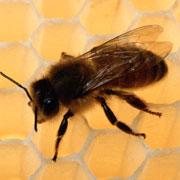 Going, going, gone? A virus could be leading bees astray.Getty
Going, going, gone? A virus could be leading bees astray.GettyA metagenomics project — studying the collective genomes from groups of organisms — has found the first firm lead in the hunt for the cause of colony collapse disorder (CCD), the perplexing phenomenon in which worker honeybees simply disappear without a trace.
CCD has hit the United States hard, wiping out between 50 and 90% of beekeepers' hives. Beekeepers and scientists have suspected everything from cell-phone radiation or climate change to mites or pesticides.
The problem has ecologists and farmers worried. Bees are valuable not only for their honey, but also as pollinators of crops including squash, apples and almonds. According to the United States Department of Agriculture (USDA), bees add $15 billion in value to crops annually and "one mouthful in three in the diet directly or indirectly benefits from honey bee pollination". A world without honey bees would be poorer indeed.
To investigate whether a disease is to blame for the disappearances, Diana Cox-Foster of Pennsylvania State University in University Park and a large group of collaborators sequenced all the microflora living inside bees, including bacteria, viruses, and fungi.
A group of some 30 people worked intensively for five months to find sequences that were associated with bees from afflicted hives.
Unhealthy hives
As the team reports in today's Science1, they found that genes of the Israeli acute paralysis virus (IAPV) matched extremely well with hives with the disorder. "If you identify IAPV in a colony, the probability is over 96% that this is going to come from a CCD hive," says lead author Ian Lipkin of Columbia University in New York. The virus was found in only a single sample that was not identified as having CCD.
The researchers stress that this doesn't prove that IAPV is causing CCD; it is possible that the virus is infecting bees while they are in a vulnerable state. But they have found a good suspect, the researchers say. "The real test will be introducing the virus to healthy bees," says Lipkin.
"I think that multiple factors are involved in CCD," adds co-author Jeffery Pettis of the USDA Bee Research Laboratory in Beltsville, Maryland. The bees from collapsing colonies were generally in much worse shape than the healthy controls, he notes. The disorder could represent the cumulative effect of the virus, parasitic mites, and external stressors, including pesticides on crops and the bumpy rides the bees take on trucks between pollination gigs.
Resistance gives hope
Israeli acute paralysis virus has been linked to bee trouble before. The virus was discovered recently by Ilan Sela, a virologist at the Hebrew University of Jerusalem in Israel, who found it in sick colonies in that country. He sequenced the virus, in collaboration with a US partner, a few years ago.
ADVERTISEMENT
In Israel the bees were dying inside the hive, rather than disappearing, so it is unclear whether the Israeli problem was the same as CCD.
Sela also found that some Israeli bees had integrated parts of the IAPV sequence into their own genomes, and that these bees seemed resistant to the virus2. If IAPV is truly the culprit of US disappearances, then Lipkin suggests these naturally resistant bees could be used to start new hives.
Visit our couldbecauseof_disapp.html">newsblog to read and post comments about this story.
